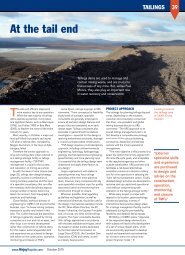Draft Status Quo Report for the Pixley Ka Seme ... - SRK Consulting
Draft Status Quo Report for the Pixley Ka Seme ... - SRK Consulting
Draft Status Quo Report for the Pixley Ka Seme ... - SRK Consulting
You also want an ePaper? Increase the reach of your titles
YUMPU automatically turns print PDFs into web optimized ePapers that Google loves.
<strong>SRK</strong> <strong>Consulting</strong> in association with BKS<br />
<strong>Pixley</strong> <strong>Ka</strong> <strong>Seme</strong> Local Municipality EMF – <strong>Draft</strong> <strong>Status</strong> <strong>Quo</strong> <strong>Report</strong> Page 45<br />
• Lack of duty of care by same communities or<br />
taking precautions to prevent crime.<br />
3.5.5 Education<br />
According to PKSLM IDP (2009/2010) <strong>the</strong>re are 44<br />
primary and secondary schools in <strong>the</strong> municipality.<br />
PKSLM does not have any tertiary institutions. The<br />
majority of <strong>the</strong> population has a basic education, but<br />
only 4% has received higher education (attending a<br />
college, technicon or university). Sixteen % of <strong>the</strong><br />
population has received no education.<br />
Esterhuysen and Smith, 2006). The database of <strong>the</strong><br />
SAHRA and <strong>the</strong> Archaeological Data Recording Centre<br />
at <strong>the</strong> National Cultural History Museum (NCHM) also<br />
do not list any Stone Age sites in PKSLM. This<br />
evidence may only indicate <strong>the</strong> lack of research in<br />
PKSLM as it is likely <strong>the</strong>re are rock art sites in <strong>the</strong> high<br />
mountains close to Wakkerstroom. This is corroborated<br />
by Hofmeyr and Smith (2009) who indicate that rock<br />
art has been identified on <strong>the</strong> farms Rietvlei,<br />
Driefontein and Doornhoek and that San people settled<br />
close to Wakkerstroom during <strong>the</strong> 1500’s.<br />
3.5.6 Cultural resources<br />
The legal context <strong>for</strong> conservation of cultural resources<br />
is provided mainly by <strong>the</strong> National Heritage Resources<br />
Act (NHRA) and NEMA. All cultural resources older<br />
than 60 years are potentially regarded as heritage and<br />
detailed studies would be required in order to determine<br />
whe<strong>the</strong>r <strong>the</strong>se indeed have cultural significance. Factors<br />
to be considered include aes<strong>the</strong>tic, scientific, cultural<br />
and religious value of such resources. Map 30<br />
represents those heritage sites considered significant in<br />
terms of Section 3(3) of <strong>the</strong> NHRA.<br />
The PKSLM has been inhabited by humans since Early<br />
Stone Age times. The relatively flat landscape with few<br />
trees would have meant that Stone Age people would<br />
probably not have settled here, although <strong>the</strong> good<br />
grazing may have encouraged hunting in <strong>the</strong> area.<br />
Cattle outposts are likely to have been situated in<br />
PKSLM during <strong>the</strong> Iron Age. During historical times,<br />
white farmers would also have settled in PKSLM due to<br />
good grazing available <strong>for</strong> <strong>the</strong>ir cattle (Van<br />
Vollenhoven, 2010).<br />
Stone Age<br />
The division <strong>for</strong> <strong>the</strong> Stone Age according to Korsman<br />
and Meyer (1999) is as follows:<br />
• Early Stone Age (2 million – 150,000 years ago);<br />
• Middle Stone Age (150,000 – 30,000 years ago);<br />
and<br />
• Late Stone Age (40,000 years ago – 1850 – A.D.).<br />
No important sites from <strong>the</strong> Early or Late Stone Age<br />
have been recorded in <strong>the</strong> study area (Inskeep, 1978;<br />
Willcocks, 1984; Phillipson, 1985; Mitchell, 2002;<br />
Iron Age<br />
Huffman (2007) divides <strong>the</strong> Iron Age as follows:<br />
• Early Iron Age (250 – 900 A.D.);<br />
• Middle Iron Age (900 – 1300 A.D.); and<br />
• Late Iron Age (1300 – 1840 A.D.).<br />
While no Early or Middle Iron Age sites have been<br />
identified in PKSLM, <strong>the</strong>re are a large number of Late<br />
Iron Ages sites (Mitchell, 2006; Bergh, 1999;<br />
Phillipson, 1984; Inskeep, 1978, SAHRA database;<br />
NCHM database). Late Iron Age sites are <strong>the</strong> easiest of<br />
archaeological sites to identify as <strong>the</strong>y usually contain a<br />
variety of stone walls and are situated against <strong>the</strong> slopes<br />
or on top of hills and mountains. In a band stretching<br />
from Wakkerstroom in <strong>the</strong> east to far within <strong>the</strong><br />
boundaries of <strong>the</strong> Free State Province (including<br />
Volksrust) 823 sites have been identified. Map 30<br />
provides approximate location of Late Iron Age sites.<br />
Remains of archaeo-metallurgy are not included in <strong>the</strong><br />
finds, although iron ore was mined by prehistoric<br />
people in <strong>the</strong> PKSLM area (Inskeep, 1978).<br />
Late Iron Age people moved into <strong>the</strong> Highveld areas of<br />
Mpumalanga by <strong>the</strong> 12 th century (Esterhuysen and<br />
Smith, 2006). Huffman (2007) indicates that Iron Age<br />
people from <strong>the</strong> Maguga facies of <strong>the</strong> <strong>Ka</strong>lundu tradition<br />
inhabited this area as early as 1100 A.D. During a<br />
recent survey in <strong>the</strong> Volksrust area some Late Iron Age<br />
stone walled sites were identified (A. Pelser, pers.<br />
comm.).<br />
Around 1,760 Swazi people settled at<br />
kwaMadlangampisi at <strong>the</strong> start of <strong>the</strong> Tshabalala<br />
dynasty (Hofmeyr and Smith, 2009). Today <strong>the</strong> Swazi’s<br />
remain <strong>the</strong> most dominant group in <strong>the</strong> area.<br />
KILI/BEAT G:\404946_PIXLEY EMF\7REPORTS\<strong>Status</strong> <strong>Quo</strong> report\<strong>Draft</strong> report\<strong>Draft</strong> status quo report, July 2010.docx July 2010









